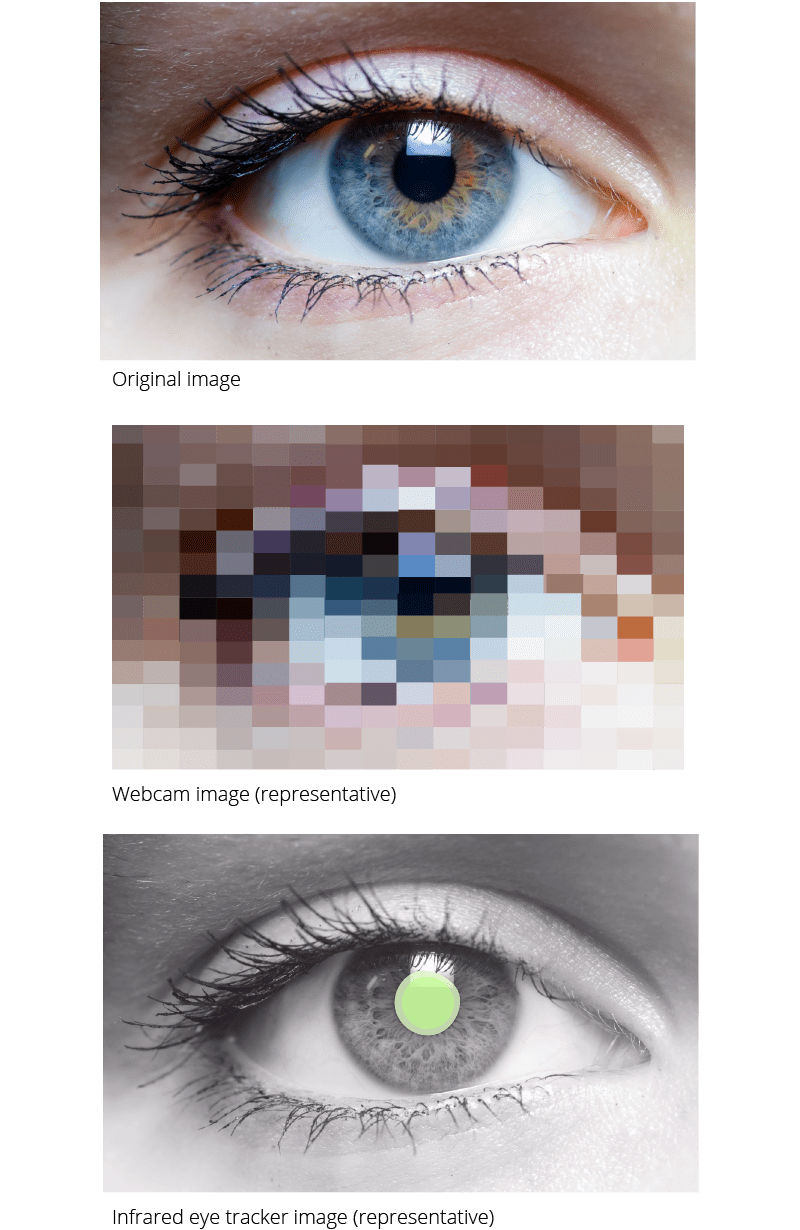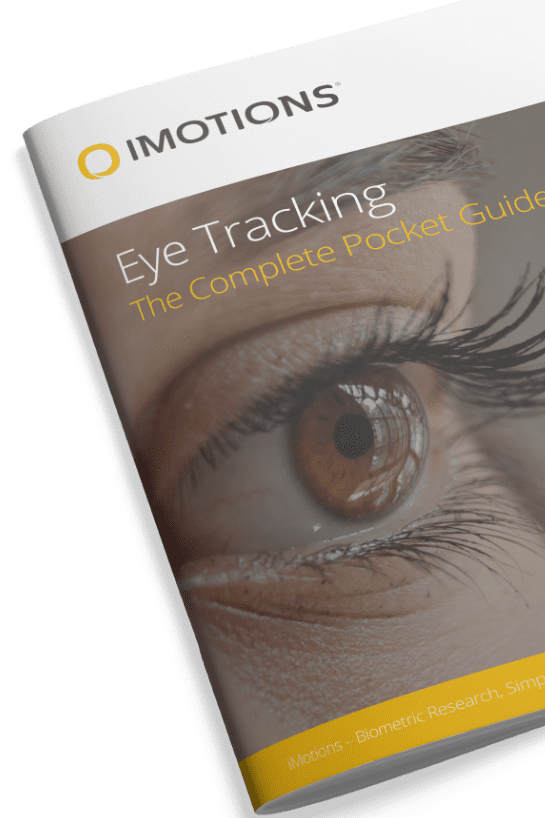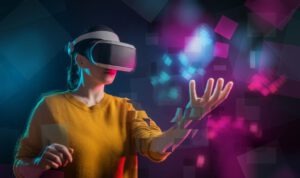Webcam eye tracking vs. eye trackers: Which is better? Explore the pros, cons, and applications of each technology to find the ideal fit for your research goals.
Table of Contents
- How Does Webcam Eye-Tracking Work?
- Visual spectrum, resolution, and contrast
- Mapping eye movement with a webcam
- Pros and cons of webcam-based eye tracking
- 4 Paid & Free Webcam Eye Tracking Software Solutions
- Advancements in Webcam and Eye Tracking Methods
- Eye tracker Vs. Webcam-based eye tracker capability recap
- Conclusion
- Eye Tracking
State-of-the-art eye tracking utilizes high-performance industry cameras that detect near-infrared spectrum light, and also benefit from active illumination in that spectrum. These features work together to create a highly accurate system for eye tracking. However other options are emerging, specifically webcam-based eye tracking, some of which will likely become strong contenders in the near future. In this post, we will dig into the world of dedicated eye tracking hardware and webcam-based eye tracking and potentially what the future holds.
How Does Webcam Eye-Tracking Work?
The typical eye tracker is a dedicated piece of camera hardware designed and optimized for capturing eye movement in any lighting condition and can compensate for head movement, and a wide range of physiological variations of the eye region.

Webcam-based eye tracking does not employ infrared diodes to capture the corneal reflections, as it’s called, it is purely a video-based eye tracker.
What that means is that webcam eye tracking is essentially getting eye tracking data from a “normal” camera – a camera that detects light in the visible spectrum. This is because we only really need or want a webcam that operates with visible spectrum light – video conferencing in near-infrared spectrum light would be a peculiar experience.
Visual spectrum, resolution, and contrast
Webcams or any consumer application cameras, are tuned for the visual spectrum. While commercially available cameras are being continuously improved upon, working with video-based eye tracking technology poses some limits:
- Visual spectrum only: no benefit from near-infrared spectrum light (which allows the algorithm to accurately detect the pupil against the surrounding iris). Video-based eye trackers recognize eyes and pupils solely from video feeds, rather than corneal reflection.
- Resolution: A typical webcam can record up to HD, but often with a trade-off in latency and frame rate. Lower resolution can resolve that, however the trade-off here is fewer pixels to describe the eye region. Fewer pixels means less information to extract the eye gaze from, and ultimately less accuracy and reliability.
- Contrast: because the webcam entirely depends on the ambient light condition, low lighting can result in even less accuracy, as there is less contrast to detect eye movements against the background of the face.

Mapping eye movement with a webcam
How is the webcam eye tracking algorithm able to detect the eyes and the pupils without relying on corneal reflection? It does so by employing a 4-step process which in simple terms looks like this:
- Detect the location of the face
- Detect the location of the eyes within the face
- Detect the orientation of the left and right eyes
- Map the orientation of the eyes onto the screen coordinate system
Most methods rely on calibration to make the mapping in Step 4. Calibration is typically done in the same way as standard eye tracking: expose a series of calibration points on the screen and ask the participant to look at those points to build a model.
Pros and cons of webcam-based eye tracking
Pros
- Cost-effective, with no expensive eye tracking hardware needed. Works with all off-the-shelf webcams.
- Endlessly scalable. Respondents can be recruited and do the survey online, regardless of where they are in the world.
- Fast turnaround time. All respondents can do the study at the same time, with no in-lab appointments. This leads to a significant reduction in data collection time and the subsequent analysis can be started faster.
Cons
- Webcam eye tracking is comparable to entry-level eye trackers, but they generally have lower accuracy and precision compared to infrared eye trackers.
- Can be impacted by participant movement and posture change.
- Frame-rate and resolution are dictated by the quality of the webcam.
As such, the pros provide the promise of making eye tracking a ubiquitous technology. Essentially it is a technology that all devices with embedded cameras could support – which today, of course, are virtually all personal computers and mobile devices.
For academic and commercial research there is a potential to collect visual attention data on any population and demographic – cheaply and fast – in much the same way as sending out a typical online survey.
However, depending on what type of research is done, there can be limitations to the quality of data collected using webcams. Primarily academic research depending in high accuracy will be dependent on screen-based eye trackers for a while yet. In that vein, the possibility of publishing research reflects the acceptance of the tools used by the scientific community. That means that webcam-based methods needs more exposure, academic review, quality assurance, and attention to respondent recruitment and yield to obtain scientifically acceptable results.
4 Paid & Free Webcam Eye Tracking Software Solutions
Several options exist if you’re interested in investigating webcam-based eye tracking further, including iMotions Online which was introduced as part of the iMotions product suite in 2024.
iMotions Online – browser-based data collection
iMotions Online is our new stand-alone, and entirely browser-based, data collection platform. Data is collected through a respondent’s browser interface and webcam to collect eye tracking and facial expression data, which can also be combined with online surveying should the study in question call for it. Data is processed and analyzed in the iMotions cloud infrastructure, maintaining integrity without compromising full, flexible functionality. iMotions Online is powered by the latest iteration of our webcam-based eye tracking algorithm WebET 3.0, which is the most accurate and thoroughly validated algorithm on the market. iMotions online is perfect for scalable, UX/UI testing, image, and video testing as well as marketing studies.
The following options are independent of iMotions, and offer more limited analysis capabilities:
GazeRecorder – Desktop
GazeRecorder is a freeware developed by independent researcher Szymon Deja. It works as an application that handles calibration and recording of eye tracking data and screen content. Video exports and raw data are available after recording.
Webgazer – Web Browser
WebGazer is a research project from Brown University. It is unique as it is built in Javascript and allows for embedding of eye tracking into a webpage.
EyeSee
EyeSee is a Belgian market research company that offers online solutions that incorporate facial expression analysis.
Advancements in Webcam and Eye Tracking Methods
Simplified components – but with near-infrared light
Before The Eye Tribe was bought by Facebook its mission was to develop robust eye tracking algorithms that can work through cheap hardware components. Their plan was not to solely rely on standard embedded cameras in devices, rather their mission was to prove that by adding only a few extra hardware components, robust eye tracking could become ubiquitous.
This ultimately meant that in addition to the already existing camera in a laptop or mobile phone, a diode providing active illumination in the near-infrared spectrum would be enough to gain the robustness needed for accurate eye tracking.
Reduced cost
Intel Realsense is a cheap hardware platform that can be purchased for a few hundred dollars and provides options to record in the non-visible spectrum as well providing a distance map for the images. Eyeware is an eye tracking startup that has developed eye tracking algorithms for these platforms.
Accuracy – through different methods
Adhawk is presenting an entirely new way to detect eye movements. Instead of using a normal camera their system relies on a MEMS scanner. The benefit is the hardware cost can be drastically reduced, and it could potentially provide very accurate measurements of the eye position.
Currently the technology mostly allows for integration into a glasses-like device, meaning that remote eye tracking with the ubiquity of webcam-based systems are not going to be immediately available.
Eye tracker Vs. Webcam-based eye tracker capability recap
In this chapter we have made an easy comparison of some key capabilities of eye trackers and webcam-based eye trackers.
Accuracy
Dedicated Eye Trackers:
- Precision: Dedicated eye trackers are designed specifically for tracking eye movements. They often use infrared sensors to detect the reflection off the cornea and the movement of the pupil. This allows for high precision and accuracy in tracking.
- Stability: These devices are less susceptible to external factors like lighting conditions, ensuring consistent performance.
- Calibration: Dedicated eye trackers typically come with sophisticated calibration procedures, ensuring that the tracking is tailored to the individual user.
Webcam-Based Eye Tracking:
- General Accuracy: While advancements have been made, webcam-based solutions tend to be less accurate than dedicated eye trackers. This is primarily because webcams are not specifically designed for eye tracking.
- Environmental Factors: Webcam-based solutions can be more sensitive to changes in lighting and may require the user to be at a specific distance or angle from the camera.
- Calibration: While calibration is possible with webcam-based solutions, it may not be as refined as with dedicated trackers.
Data Analysis
Dedicated Eye Trackers:
- Rich Data: These trackers can provide a wealth of data, including gaze plots, heat maps, and saccade paths. This data can be used to analyze user behavior in great detail.
- Software Integration: Many dedicated eye trackers come with proprietary software tailored for in-depth analysis, making it easier for researchers and professionals to interpret the data.
Webcam-Based Eye Tracking:
- Basic Analysis: While some software solutions can offer heat maps and gaze plots, the data might not be as detailed or accurate as that from dedicated trackers.
- Flexibility: One advantage of webcam-based solutions is that they can be integrated into a variety of applications, given the ubiquity of webcams. This can be beneficial for developers looking to incorporate basic eye tracking into their software.
Research and Professional Applications
Dedicated Eye Trackers:
- Research: In fields like psychology, neuroscience, and marketing, the precision of dedicated eye trackers is invaluable. They allow researchers to gather detailed insights into visual attention and cognitive processes.
- Professional Applications: In industries like gaming, assistive technology, and user experience (UX) design, dedicated eye trackers offer a level of precision that can significantly enhance the end product or user experience.
Webcam-Based Eye Tracking:
- Research: For preliminary studies or when high precision is not a priority, webcam-based solutions can be a cost-effective alternative.
- Professional Applications: In scenarios where basic eye tracking can enhance user experience-such as in some video games or e-learning platforms-webcam-based solutions can be integrated without the need for additional hardware.
While dedicated eye trackers offer superior accuracy and data analysis capabilities, webcam-based eye tracking solutions provide a more accessible and flexible option for certain applications. The choice between the two largely depends on the specific requirements of the task at hand. As technology continues to evolve, we can anticipate further improvements in both dedicated and webcam-based eye tracking solutions.
Conclusion
Ultimately, regardless of the chosen method, the usefulness of eye tracking types depends on how it will be used. If the intention is to determine where a respondent has looked at a particular part of a screen, then webcam-based methods may well fulfill that. Areas such as neuromarketing, UX/UI testing and video and image testing, can greatly benefit from using webcam-based eye tracking. However, if greater spatial or temporal resolution is required, then infrared eye trackers will be essential.
As with all technology, the best is yet to come. Future hardware and software integrations will become more and more sophisticated and will begin to compete with dedicated eye trackers. The state of the field now, as we in iMotions see it, is that webcam eye tracking is moving into the sphere of being a very viable option for certain types of research and data collection.
Especially in areas where data collection concerns images, videos or websites, webcam-based eye tracking can significantly speed up any study. At this point in time, commercial entities can benefit from using webcam-based eye tracking to gain deeper insights that can be gained more frequently, hastening product development and optimizing marketing strategies. On the academic side of things webcam-based eye tracking can be a powerful teaching tool when teaching eye tracking specifically, and human behavior in general.
We hope that you’ve found this breakdown of webcam-based eye tracking to be helpful. If you’d like to learn more about the details of eye tracking then download our free, comprehensive guide below or contact us if you would like to know more about iMotions and our eye tracking solutions.
Eye Tracking
The Complete Pocket Guide
- 32 pages of comprehensive eye tracking material
- Valuable eye tracking research insights (with examples)
- Learn how to take your research to the next level

Psychology Research with iMotions
The world’s leading human behavior software










